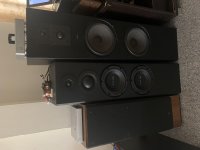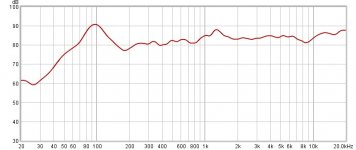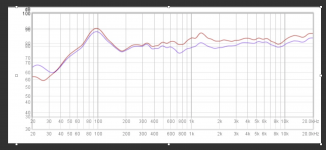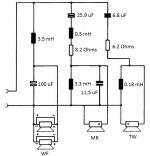2,5mH 1st order 8 ohm is 500 Hz. Makes sense for baffle step compensation assuming the two 4 ohm series driver have higher sensitivity than the mid, like 92dB combined. This is not your case with the dual voicecoil subs, you really need to scrap those driver and try something more traditional hifi bass drivers, these are not fit they are meant for active 80Hz. Can you post a picture of your build and the bass drivers?
Sorry I see it’s second order. Looks like intended xo is 800Hz at 8 ohm load. But you don’t have 8 ohm. But you should. Hence the problem. Also sensitivity mismatch.
2,5mH 1st order 8 ohm is 500 Hz. Makes sense for baffle step compensation assuming the two 4 ohm series driver have higher sensitivity than the mid, like 92dB combined. This is not your case with the dual voicecoil subs, you really need to scrap those driver and try something more traditional hifi bass drivers, these are not fit they are meant for active 80Hz. Can you post a picture of your build and the bass drivers?
Here is the photo of my builds. The center is the issue pair. The left is a commercial speaker. The right is a clone of the left with changing woofers to dual instead of single and modified bass’ crossover section.
Attachments
Hmm, we're just 'spinning our wheels', so at this point if replacing woofers isn't an option then post measurements of just each driver to see if there's enough overlapping BW to make new XOs with as much of the components you have and either 'it is what it is' or buy whatever else you may need.
Also, ideally need measured specs of each woofer since IME mobile audio specs are just wishful thinking, especially WRT efficiency.
GM
Also, ideally need measured specs of each woofer since IME mobile audio specs are just wishful thinking, especially WRT efficiency.
GM
First suggestion: disconnect the bottom woofer from the crossover, shortcut it's voice coil and listen. If things get better then consider connecting the bottom woofer with a separate lowpass filter (think of anything in the range of 6m8 to 10m or even bigger coils, together with 100µ).
Second suggestion: wire ALL voice coils of the woofers in series to get 16Ω and connect them to the crossover. I suspect the woofers have high Le values (inductance of the voice coil) and a series connection together with the coil in your crossover could bring the lowpass in the 800Hz region. As you'll still have about the same output per Volt input at low frequencies, don't worry about efficiency too much. Be it that I wouldn't do 800Hz with two 8" woofers anyway.
Second suggestion: wire ALL voice coils of the woofers in series to get 16Ω and connect them to the crossover. I suspect the woofers have high Le values (inductance of the voice coil) and a series connection together with the coil in your crossover could bring the lowpass in the 800Hz region. As you'll still have about the same output per Volt input at low frequencies, don't worry about efficiency too much. Be it that I wouldn't do 800Hz with two 8" woofers anyway.
I had experimented on changing series resistors on mid and tweeter, I got the result on attached graph.
Initially, I'm satisfied with this result. With this crossover, I could hear the continuity from mid to tweeter and the well detail from these two drivers. The tonal balance seemed to be better! Yet, the bass was still a little bit shy. I recognized that the mid and the tweeter were good with 2 Ohms difference from each other. But, the bass is somewhat needing more attenuation on mid+high to gain its appearance. Consequently, I'm going to play more on the resistors.
According to the graph, I think it may need some more about 2-3 Ohms on mid and tweeter -- Now they're 8.2 and 6.2 Ohms, respectively. However, I'm also unsure if there will be a problem with the amplifier. Does anybody have any comments on this?
Initially, I'm satisfied with this result. With this crossover, I could hear the continuity from mid to tweeter and the well detail from these two drivers. The tonal balance seemed to be better! Yet, the bass was still a little bit shy. I recognized that the mid and the tweeter were good with 2 Ohms difference from each other. But, the bass is somewhat needing more attenuation on mid+high to gain its appearance. Consequently, I'm going to play more on the resistors.
According to the graph, I think it may need some more about 2-3 Ohms on mid and tweeter -- Now they're 8.2 and 6.2 Ohms, respectively. However, I'm also unsure if there will be a problem with the amplifier. Does anybody have any comments on this?
Attachments
Try to have a 8 ohm load all over. I’m surprised you don’t hear the 100Hz bump. Could it be something wrong with the mic? Could you share an updated xo diagram showing also all the dual coil subs (4x4 ohm and how you ended up wiring them all for the result above)? If the crossover was intended for 8 ohm you should try to have that on all drivers to avoid the cutoff frequencies to change. I don’t even want to think about what happens when using a 4 ohm or 16 ohm load on a second order 8 ohm crossover, the serial and parallel inductors and capacitors will move in opposite directions only reducing sensitivity further. I think here is still your problem. The bass drivers are not right impedance and also let sensitive that mid and high. You can attenuate both but as long as low is 4 or 16 ohm it will never really work as intended. You can try with only one bass driver serial connect both coils as you have separate chambers. Leaving the other unused. You can then use LPAD to lower mid and hf but make sure always 8 ohm.
This would only happen if the crossover is not done correctly. The designer should be careful with this, and if the impedance varies the result can still be good.If the crossover was intended for 8 ohm you should try to have that on all drivers to avoid the cutoff frequencies to change.
Always some interesting advice on these DIY forums, which tbh is why I took a big step back from taking part, that and my career took more time than I wanted. Thanks to COVID I can give a (little) time to this. When I read my old posts I'm embaressed by the lack of knowledge and overly cocky attitude, but it seems that's a common problem in this hobby and there's a few people posting here that need to go away and learn about the subject before they post ill informed 'advice'.
I won't target any individuals as I've probably rubbed feathers way too far the wrong way already, just to say take any free advice on a forum such as this with a large grain of salt.
I will directly respond on the comment that the D75MX can't cross below 800Hz; does this comment come from experience with that driver? The whole advantage of the D75 over the (currently more popular-not that mid domes are) 2" domes is that it can dig lower. I have a pair of D75MX's running right now. They're lovely, they play very loud. They crossover at around 350Hz if I recall rightly. I'd have to dig out the FR graphs.
key point there is that they're running on 4th order electrical filters - I can't remember what the FR slopes looked like as at that point I was aiming for flat response and phase integration with the bass woofer.
So yes, they can go lower, but the lower you go the harder you need to cross them over.
Anyway, some key things haven't been said yet.
- Well done for a lovely looking speaker, looks very well finished and certainly something to be proud of.
- Well done for what you've achieved so far. Getting FR that good with those drivers is tricky!
Now lets get to the important parts
- What's your goal here? are you just looking to tweak what you have or do you want to work on the complete design? i.e. would you change XO completely or are you broadly happy enough that you're just tweaking levels now?
- sorry if its been asked already, but from what I understand those woofers are dual coils, do we have woofers in parallel but coils in series?
- please can you get us individual DCR measurements for each woofer coil?
- Please can you confirm how you're measuring? Is it a calibrated measurement microphone?
I won't target any individuals as I've probably rubbed feathers way too far the wrong way already, just to say take any free advice on a forum such as this with a large grain of salt.
I will directly respond on the comment that the D75MX can't cross below 800Hz; does this comment come from experience with that driver? The whole advantage of the D75 over the (currently more popular-not that mid domes are) 2" domes is that it can dig lower. I have a pair of D75MX's running right now. They're lovely, they play very loud. They crossover at around 350Hz if I recall rightly. I'd have to dig out the FR graphs.
key point there is that they're running on 4th order electrical filters - I can't remember what the FR slopes looked like as at that point I was aiming for flat response and phase integration with the bass woofer.
So yes, they can go lower, but the lower you go the harder you need to cross them over.
Anyway, some key things haven't been said yet.
- Well done for a lovely looking speaker, looks very well finished and certainly something to be proud of.
- Well done for what you've achieved so far. Getting FR that good with those drivers is tricky!
Now lets get to the important parts
- What's your goal here? are you just looking to tweak what you have or do you want to work on the complete design? i.e. would you change XO completely or are you broadly happy enough that you're just tweaking levels now?
- sorry if its been asked already, but from what I understand those woofers are dual coils, do we have woofers in parallel but coils in series?
- please can you get us individual DCR measurements for each woofer coil?
- Please can you confirm how you're measuring? Is it a calibrated measurement microphone?
Well, I didn't mention 800Hz. The D75 varieties are known for best performance from 600-700Hz (even the data sheet says so) and I have listened to (and measured on) those midranges quite a lot, back in the late '80s and early '90s. I won't argue they can do 350Hz, but you will be out of Xmax at about 100dB. Yes, midranges max out too. Now you may find that very loud, my advice was and would be otherwise.
Your original setup (purple line) might be better.
The purple line, with carefully look, was actually an inclined slope. Thus, it produced a little more sibilance than the orange line in real listening. The orange line seemed to produce better balance for mid and high, but, worse balance for mid and bass.
Try to have a 8 ohm load all over. I’m surprised you don’t hear the 100Hz bump. Could it be something wrong with the mic? Could you share an updated xo diagram showing also all the dual coil subs (4x4 ohm and how you ended up wiring them all for the result above)? If the crossover was intended for 8 ohm you should try to have that on all drivers to avoid the cutoff frequencies to change. I don’t even want to think about what happens when using a 4 ohm or 16 ohm load on a second order 8 ohm crossover, the serial and parallel inductors and capacitors will move in opposite directions only reducing sensitivity further. I think here is still your problem. The bass drivers are not right impedance and also let sensitive that mid and high. You can attenuate both but as long as low is 4 or 16 ohm it will never really work as intended. You can try with only one bass driver serial connect both coils as you have separate chambers. Leaving the other unused. You can then use LPAD to lower mid and hf but make sure always 8 ohm.
Ok, the updated schematic is on attached. The woofer section was actually 4 Ohms load, not 8 Ohms. And the crossover was intended for 4 Ohms load.
IMO, the crossover design was correct but the problem may be caused by the enclosure and the woofers themselves. The 1.5 cu.ft. for each woofer will provide the result similar to the infinite baffle, indicated on the datasheet of the woofer but I didn't post here, resulting in very low Qtc (approx. 0.34). And another woofers themselves cause may be from the assumption on post #17.
Attachments
Last edited:
Hint taken, I think I may be one of those people, I tend to jump in on topics where I see some obvious issues but I may actually not bring anything valuable to the discussion with my limited know-how. I’ll get out of this thread and a few others and rather stick to the ones I can contribute with some real content. Thanks for the constructive criticism and the respectfully approach on the issue.... there's a few people posting here that need to go away and learn about the subject before they post ill informed 'advice'.
Lol.
Everyone better shut up.
But nannoo had one good question. The OP could tell us more about the measurement setup.
Everyone better shut up.
But nannoo had one good question. The OP could tell us more about the measurement setup.
Lol.
Everyone better shut up.
But nannoo had one good question. The OP could tell us more about the measurement setup.
Oh, I’m sorry. I didn’t intend to shut up everyone including you. There were so many replies and questions and I couldn’t catch them all. I just wanted to share my experience and updated the result. Also, english is not my mother-tongue language. Sometimes, I must confess that it is hard for me to state in beautiful words or correct contents that I intended to communicate. Please forgive me. Your all advices are valuable. And I would love to hear them further. At least, it could be useful to other people that read and have the same problems with me.
The measurement setup consists of an RTA mic; Superlux ECM-888B, I’m not sure if it’s Chinese made or not, but I have it two and they produce the same result in comparison test; a PC with Realtek sound card, not sure about the model; and a REW V5.19 program. The mic was placed at 1m. height and 1m. far from the front baffle of the speaker. Room size is 11x12x7.5 ft.
Hi All,
Wasn't looking to put anyone down or pick a fight, just wanted to push things in a positive direction.
fabricadetabaco - NONE of my comments were aimed at you. But btw the reason you don't hear room characteristics like 100hz bumps that show up in measurements is because your ear isn't in the measurement position! An interesting thing to do is go to online tone generator and play a few bass frequencies (40-120 Hz). Leave a single bass tone playing and move around the room, particularly from corners to wall edges and centre - more than likely you'll find some real peaks and troughs. I could share the wave equation with you if you like but it's some ugly calculus where as the practical intuition is simple.
markbakk - None of my comments were aimed at you either!, a previous comment from another user mentioned 800Hz which seemed to be plucked out of thin air!
Not sure at what dB output my 75's would run out of xmax or start distorting beyond acceptable levels... Would be an interesting test for another thread. Out of interest can you share the datasheet with the frequency recommendation for the d75 dome? I have copies of the D75MX (31 and 41 variants) and the subsequent scan speak replacement but couldn't spot a mention of recommended frequency use. I have a very old version of the 31 variant datasheet which suggests a possible 2nd order electrical schematic for a 500hz Fc but that's it. If you can share the datasheet you're referring to it would be great to see it.
Presscot - Thank you for the information about your coil wiring in the woofers, and about your measurements. We need to know that what you're measuring is correct - that comes down to gating the impulse response (likely quite a short gate with a small room like that as you'll get rapid reflections). Putting up lots of blankets/duvets on floor and behind the microphone will help. Also try to measure on the diaganol and not facing a wall. A good test of a microphone without measurement is a low level close proximity FR sweep of a known driver that always measures very close to the spec sheet. If you measure 3 different drivers and get the same FR graph as the manufacturer for all 3 you're winning.
Also, a silly question but have you sealed the midrange from the woofers? The D75's are open backed and must have a sealed volume, around 1.7-2L if I remember correctly.
You said about general advice for tuning speakers. My advice if you're only changing resistance values is to to bring your peaks down ( NOT your dips up) ears are more sensitive to peaks in frequency response than dips. Adjust the levels so peaks from the mid dome and tweeter land at the same output as most of the bass and if you're lucky you'll have a good sound that isn't fatiguing.
Good luck, let us know what you want different and what you're willing to change.
Wasn't looking to put anyone down or pick a fight, just wanted to push things in a positive direction.
fabricadetabaco - NONE of my comments were aimed at you. But btw the reason you don't hear room characteristics like 100hz bumps that show up in measurements is because your ear isn't in the measurement position! An interesting thing to do is go to online tone generator and play a few bass frequencies (40-120 Hz). Leave a single bass tone playing and move around the room, particularly from corners to wall edges and centre - more than likely you'll find some real peaks and troughs. I could share the wave equation with you if you like but it's some ugly calculus where as the practical intuition is simple.
markbakk - None of my comments were aimed at you either!, a previous comment from another user mentioned 800Hz which seemed to be plucked out of thin air!
Not sure at what dB output my 75's would run out of xmax or start distorting beyond acceptable levels... Would be an interesting test for another thread. Out of interest can you share the datasheet with the frequency recommendation for the d75 dome? I have copies of the D75MX (31 and 41 variants) and the subsequent scan speak replacement but couldn't spot a mention of recommended frequency use. I have a very old version of the 31 variant datasheet which suggests a possible 2nd order electrical schematic for a 500hz Fc but that's it. If you can share the datasheet you're referring to it would be great to see it.
Presscot - Thank you for the information about your coil wiring in the woofers, and about your measurements. We need to know that what you're measuring is correct - that comes down to gating the impulse response (likely quite a short gate with a small room like that as you'll get rapid reflections). Putting up lots of blankets/duvets on floor and behind the microphone will help. Also try to measure on the diaganol and not facing a wall. A good test of a microphone without measurement is a low level close proximity FR sweep of a known driver that always measures very close to the spec sheet. If you measure 3 different drivers and get the same FR graph as the manufacturer for all 3 you're winning.
Also, a silly question but have you sealed the midrange from the woofers? The D75's are open backed and must have a sealed volume, around 1.7-2L if I remember correctly.
You said about general advice for tuning speakers. My advice if you're only changing resistance values is to to bring your peaks down ( NOT your dips up) ears are more sensitive to peaks in frequency response than dips. Adjust the levels so peaks from the mid dome and tweeter land at the same output as most of the bass and if you're lucky you'll have a good sound that isn't fatiguing.
Good luck, let us know what you want different and what you're willing to change.
- Home
- Loudspeakers
- Multi-Way
- Could I have comments on my design?



